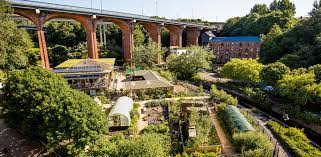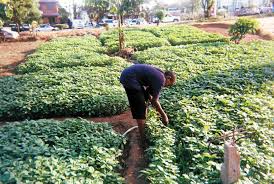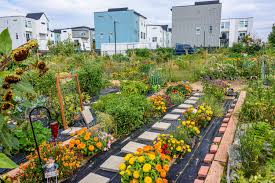The rapid growth of cities in the developing world is placing enormous demands on urban food supply systems. Agriculture including horticulture, livestock, fisheries, forestry, and fodder and milk production is increasingly spreading to towns and cities.
Urban agriculture provides fresh food, generates employment, recycles urban wastes, creates greenbelts, and strengthens cities’ resilience to climate change.
Urban agriculture also known as urban farming, urban horticulture, or foodscaping is becoming increasingly popular in societies across the world.
It offers many benefits, including food security for people in the city, reduced energy use in conventional agricultural practices and food services, lower carbon footprints, and environmental services through the provision of open green space.
Urban agriculture utilizes city resources that would otherwise go to waste. Gardens can be established in vacant lots, on rooftops, steep slopes, and riverbanks locations that would otherwise be unproductive.
These gardens may use wastewater for irrigation, addressing the challenge of wastewater treatment.
Compost from food scraps collected across the city can be applied, transforming waste into valuable nutrients. City farms convert unused resources into food, jobs, and a variety of less measurable community benefits.
Read Also: How to Grow, Use and Care for Whitetinge Sedge Grass (Carex albicans)
Background, Definition, and Functions of Urban Agriculture

1. Historical Background of Urban Agriculture
City dwellers have been growing their own food for millennia. However, it was not until the mid-1990s that the concept of urban agriculture (UA) began to receive formal recognition in research and public policy.
Before then, interest in unregulated “city farming” was largely limited to academic research, often conducted by individual scholars focusing on the informal economy.
Rising energy and food costs, water scarcity, and concerns over food safety later shifted attention to issues such as food security, eco-development, and self-reliance.
Eventually, the perspective broadened to include urban environmental management and sustainability, including waste recycling.
Food grown in urban areas may be consumed by the grower, shared with family, friends, or neighbors, or sold to other urban consumers.
In contrast, flower or rain gardens, although common, are not considered urban agriculture unless they produce food. Urban agriculture can be practiced on various land tenure types private, public, or institutional land.
It is a valuable means for poor urban populations to combat food scarcity and hunger. Growing crops or raising livestock in backyards or vacant plots enhances food sources and provides income opportunities, especially among the urban poor.
2. Definition of Urban Agriculture in Agricultural Context
Urban agriculture, urban farming, or urban gardening is defined as the practice of growing fruits, herbs, vegetables, and raising animals within city boundaries.
It includes several associated activities such as processing and distributing food, collecting and reusing food waste and rainwater, and educating, organizing, and employing local residents.
It can also be broadly described as growing food in urban areas and covers a range of activities including home gardens, school gardens, rooftop gardens, community gardens, livestock keeping, poultry, beekeeping, commercial farming, and the use of structures like greenhouses and hoophouses.
Some definitions also include post-production activities like processing, distribution, and marketing. Urban agriculture may be commercial, non-commercial, or a mix of both. It can range from a small container garden on a balcony to agricultural fields spanning many acres.
It is deeply embedded in local communities and urban systems, including city plans, policies, and budgets. The definition accommodates a broad spectrum of growing environments and practices.
Main Functions of Urban Agriculture in the Urban Environment
Urban farming performs several important functions:
1. Source of fresh and safe products, including organic and low-chemical crops.
2. Opportunity for urban residents’ engagement in agricultural activities.
3. Open space for disaster management, such as fire prevention and evacuation zones during disasters.
4. Resource for recreation and well-being, offering green spaces for personal and spiritual comfort.
5. Platform for education and awareness-raising on agriculture and food issues.
6. Contribution to sustainability and urban well-being.
7. Promotion of biodiversity and ecosystem services.
8. Reduction in food miles and provision of bio-energy resources through activities like managed forestry.
Read Also: How to Grow, Use and Care for Whitegrass (Leersia virginica)
Types and Characteristics of Urban Agriculture Based on Agricultural Context

Urban agriculture includes a wide range of farming systems, which vary based on socio-economic, physical, geographic, and political factors.
The six key factors that determine the types and characteristics of urban agriculture are the products, economic activities, location, production scale and technology, product destination, and the actors involved.
1. Types of Products in Urban Agriculture
Urban agriculture may involve a variety of crops (grains, root crops, vegetables, mushrooms, fruits) or animals (poultry, rabbits, goats, sheep, cattle, pigs, guinea pigs, fish) or combinations of both. Perishable and high-value items like vegetables and animal products are often preferred.
Non-food items include medicinal herbs, ornamental plants, tree products (wood, seeds, fuel), and seedlings. Urban production units tend to be more specialized than rural ones, and exchanges often occur among units.
2. Types of Economic Activities in Urban Agriculture
Urban agriculture includes not only production but also processing and marketing, input production, and service delivery (e.g., veterinary services) by specialized micro-enterprises or NGOs. The interconnection of these activities forms chains or clusters.
Urban agricultural production, marketing, and processing are often closely linked in time and space due to the urban setting, where agglomeration economies often outweigh economies of scale.
3. Types of Location in Urban Farming
Urban agriculture can be practiced within city limits (intra-urban) or in surrounding peri-urban areas. Activities may occur on homesteads (on-plot) or at other sites (off-plot), and on private, public, or semi-public land, including parks, school grounds, hospital compounds, road verges, and riverbanks.
4. Scales of Production and Technology Use
Urban farming includes individual or family farms, cooperatives, micro-, small-, and medium-sized enterprises, and large-scale commercial operations. Most urban farms in developing countries use low-technology systems, although there is a growing trend towards more intensive and technologically advanced operations.
5. Product Destination and Market Orientation
In many developing cities, a large portion of urban agriculture output is for household consumption, with surplus sold locally. However, market-oriented urban farming is significant in terms of volume and economic value.
Produce is sold at farm gates, by carts in neighborhoods, in local shops and markets, or to intermediaries and supermarkets. While most products are sold fresh, some are processed for household use, street vending, or packaged for sale.
6. Types of Actors Involved in Urban Agriculture
A significant proportion of urban farmers are from low-income groups, though they are often not the most marginalized.
Contrary to common belief, many are not recent rural migrants. Participants in urban agriculture may also include government employees, teachers, and wealthier individuals viewing it as a sound investment.
Do you have any questions, suggestions, or contributions? If so, please feel free to use the comment box below to share your thoughts. We also encourage you to kindly share this information with others who might benefit from it. Since we can’t reach everyone at once, we truly appreciate your help in spreading the word. Thank you so much for your support and for sharing!

